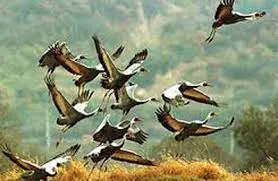Pakistan has unmatched wondrous landscape beauty, natural resources, waterways, lagoons which attract hundreds of thousand migratory birds each year.
The country provides breeding sites to many species of migratory birds. After a stay of around four months, these avian guests return to their homelands in March. These migratory birds include both aquatic and terrestrial birds. Migration of birds is also described as regular seasonal movement between wintering and breeding grounds of south and north flyways. Flyways are defined as flight pathways that are taken by migratory birds while moving between their overwintering quarters and breeding grounds. These flyways could include distance covered over oceans or continents, etc. Pakistan is included in the list of countries that are covered by the Central Asian Flyway. Other terms are Central Asian-South Asian Flyway and Central Asian-Indian Flyway. This flyway covers the huge Eurasian continental areas between the Indian Ocean, Arctic Ocean, and islands linked with these oceans. Migratory birds of Pakistan include ducks, cranes, geese, flamingos, swans, flacons, and waders. Common species of migratory birds in Pakistan include gulls, ducks-mallards, plovers, stints, snipes, cormorant, northern shoveler, common teal, common pochards, cranes, skuas and jaegers, storks, etc. Migratory birds fly from China and Russia due to extreme cold weather and cover 4,500 kilometers distance of north by using the Indus flyway to reach Pakistan.
These migratory birds stop at wetlands and water bodies present in southern Pakistan. Migratory birds usually move from Siberia, over Afghanistan, and finally into Pakistan during the winter season.
They arrive at the end of August and leave in February. In Punjab, a survey data of around a dozen locations collected by the Punjab Wildlife Research Institute, in the province frequented by the migratory birds shows that an estimated 60,011 Siberian birds were recorded in the province in 2021-2022. In the survey for 2022-2023, this number has dropped by 34 per cent to 40,000 birds. Dr, Misbah Sarwar, the research institute’s Deputy Director, told APP regarding the survey and the implications of its results, that purpose of the data collection through surveys is to estimate the maximum accurate number of birds that arrive the province every year and to prepare recommendations for their conservation, protection, and recreational hunting.
To a query, regarding the decrease in migratory birds’ population witnessed in the Wildlife Research Institute’s current survey, Dr Sarwar confirmed that the number of visitor birds from Serbia had declined because of factors like shortage of water in lagoons, wetlands, and increasing human intervention, illegal hunting, climate change impact and weather changes. However various other experts told media in response to the data of Wildlife research, they were of the opinion that the government needed to focus on the conservation of migratory birds by reducing human intervention, and eliminating pollution. In this connection, the environmental laws need to be strictly enforced.










